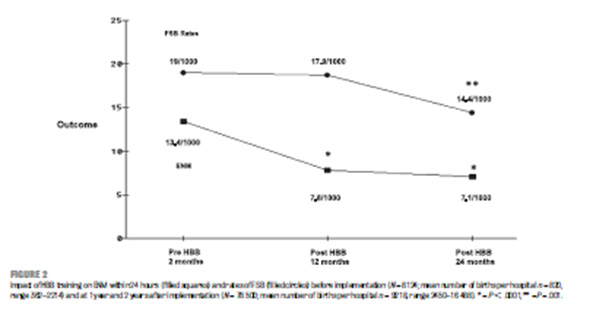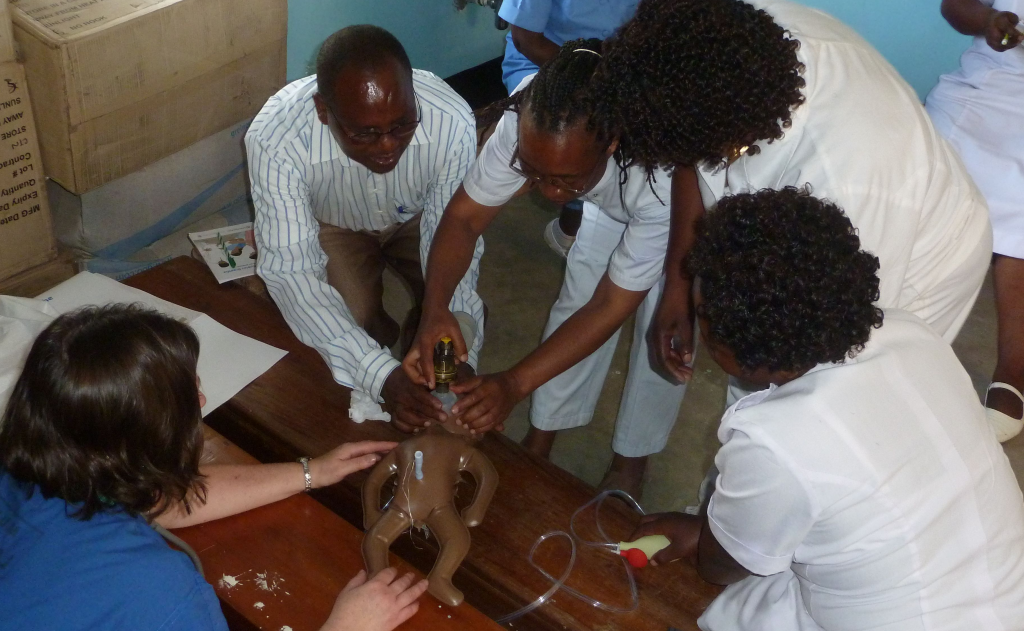Helping Babies Breath (5 Steps)
Step 1: IDENTIFY AND QUANTIFY THE PROBLEM
- Birth asphyxia, or failure to initiate or sustain spontaneous breathing at birth, contributes to ∼27% to 30% of neonatal deaths in resource-limited countries, including Tanzania.
- Mortality rates have been high and unchanged for many years.
- Millennium Development Goal (MDG) 4, which in 2000 called for a two-thirds reduction in mortality risks of children under 5 years of age by 2015, which translates to an average annual reduction of 4.4%
Msemo, G, Massawe, A, Mmbando, D ,Rusibamayila, N, Manji, K., Kidanto, HL, Mwizamuholya, D, Ringia, P, Ersdal, HL, Perlman, J (2013). Newborn Mortality and Fresh Stillbirth Rates in Tanzania After Helping Babies Breathe Training. Pediatrics 131(2). e353-360.
Step 2: IDENTIFY DECISION MAKER
Health Minister
Msemo, G, Massawe, A, Mmbando, D ,Rusibamayila, N, Manji, K., Kidanto, HL, Mwizamuholya, D, Ringia, P, Ersdal, HL, Perlman, J (2013). Newborn Mortality and Fresh Stillbirth Rates in Tanzania After Helping Babies Breathe Training. Pediatrics 131(2). e353-360.
Step 3: PROPOSE & SELL SOLUTION
The Helping Babies Breathe program addresses the most common problems of neonatal deaths, using highly pictorial learning materials and low-cost simulators. Since no electricity or special technology is required, HBB can be taught anywhere learners can come together, making it very accessible to audiences in resource-limited countries around the world.
Msemo, G, Massawe, A, Mmbando, D ,Rusibamayila, N, Manji, K., Kidanto, HL, Mwizamuholya, D, Ringia, P, Ersdal, HL, Perlman, J (2013). Newborn Mortality and Fresh Stillbirth Rates in Tanzania After Helping Babies Breathe Training. Pediatrics 131(2). e353-360.
Step 4: MEASURE OUTCOMES & MILESTONE
After the Helping Babies Breathe program was implemented in 8 hospitals in Tanzania in 2009, there was a sustained 47% reduction in early neonatal mortality within 24 hours and a 24% reduction in fresh stillbirths after 2 years.

Msemo, G, Massawe, A, Mmbando, D ,Rusibamayila, N, Manji, K., Kidanto, HL, Mwizamuholya, D, Ringia, P, Ersdal, HL, Perlman, J (2013). Newborn Mortality and Fresh Stillbirth Rates in Tanzania After Helping Babies Breathe Training. Pediatrics 131(2). e353-360.
Step 5: DEMONSTRATE & REPORT VOI/ROI
The HBB project is interesting in that pilot data at Haydom Hospital demonstrated a positive ROI. The larger regional project subsequently confirmed the positive results.
From article by Vossius C, Lotto E, Lyanga S, Mduma E, Msemo G, Perlman J & Ersdal HL. (2014). Cost-effectiveness of the “helping babies breathe” program in a missionary hospital in rural Tanzania. PLoS One. 9;9(7):e102080. doi: 10.1371
- At baseline, there were 4786 births in 12mos at Hyadom Hospital in Tanzania
- In the first full year following implementation, there were 4734 births
- There were 11.2 deaths/1000 deliveries at baseline and 7.2 deaths/ 1000 deliveries following implementation of HBB
- Total deaths decreased from 53 to 34 following implementation equaling 19 lives saved.
- At the time of the study the average life expectancy was 55.4 years
- 19 (lives saved) X 55.4 years (life expectancy ) = 1052 life years saved.
Costs associated with Implementation
- Training/retraining and materials associated with initial implementation = USD 4431
- Laerdal donated equipment
- Cost per life saved = USD 4431/ 19 = USD 233 per life saved
- Cost per life year saved = USD 4431/ 1052 years = USD 4.21/life year saved

Ongoing costs
- Annual Refresher Course Cost =USD 1515
- Annual cost per life saved= USD 1515/ 19 lives saved = USD 80 life saved
- Cost per life year saved = USD 1515/ 1052. Life years saved= USD 1.44 per life year saved.
Disability Adjusted Life years (DALY): a measure of overall disease burden, expressed as the number of years lost due to ill-health, disability or early death.
The total number of DALYs averted was 578 DALYs if age weighting and discounting was applied and 1053 without age weighting and discounting. Converted to International Dollars (ID) the costs would amount to ID 22.75 per DALY averted and ID 12.49 per DALY averted, respectively for the two scenarios (table 3).
- To range the costs of an intervention per DALY, the WHO discerns three categories of cost-effectiveness:
- Highly cost-effective (less than gross domestic product (GDP) per capita);
- Cost-effective (between one and three times GDP per capita); and
- Not cost-effective (more than three times GDP per capita) [WHO-CHOICE; 23].
- As the GDP per capita in Tanzania is ID 2154 the HBB program can be ranged as highly cost-effective.
From article by Chaudhury, S, Arlington, L, Brenan, S, Kairuki, AK, Meda, AR, Isangula, KG, Mponzi, V, Bishanga, D, Thomas,E, Msemo4, G, Azayo, M, Molinier, A. & Nelson, BD . (2016). Cost analysis of large-scale implementation of the ‘Helping Babies Breathe’ newborn resuscitation-training program in Tanzania, BMC Health Services Research. 16:681
47% reduction in mortality at a cost of $202,240
Data available before HBB program implemented:
- # of babies born alive = 7862
- # of babies who died = 107
- # of stillbirths = 155
After initiation of HBB:
- # of babies born alive = 76 817
- # of babies who died = 552)
- # of stillbirths = 1131
Total costs for the initial HBB program in the Mbeya Region of Tanzania were $202,240, with the highest proportion due to initial training and equipment (45.2%), followed by central mainland program administration (37.2%), and follow-up visits (17.6%).
Within Mbeya, 49 training sessions were undertaken, involving the training of 1,341 health providers from 336 health facilities in eight districts.
To similarly expand the HBB program across the 25 regions of Tanzania, the total economic
cost is projected to be around $4,000,000 (around $600 per facility). Following sensitivity analyses, the estimated total for all Tanzania initial rollout lies between $2,934,793 to $4,309,595. In order to maintain the program nationally under the current model, it is estimated it would cost $2,019,115 for a further one year and $5,640,794 for a further five years of ongoing program support.
REFERENCES
Msemo, G, Massawe, A, Mmbando, D ,Rusibamayila, N, Manji, K., Kidanto, HL, Mwizamuholya, D, Ringia, P, Ersdal, HL, Perlman, J (2013). Newborn Mortality and Fresh Stillbirth Rates in Tanzania After Helping Babies Breathe Training. Pediatrics 131(2). e353-360.
Chaudhury, S, Arlington, L, Brenan, S, Kairuki, AK, Meda, AR, Isangula, KG, Mponzi, V, Bishanga, D, Thomas,E, Msemo4, G, Azayo, M, Molinier, A. & Nelson, BD . (2016). Cost analysis of large-scale implementation of the ‘Helping Babies Breathe’ newborn resuscitation-training program in Tanzania, BMC Health Services Research. 16:681 DOI 10.1186/s12913-016-1924-2
Vossius C, Lotto E, Lyanga S, Mduma E, Msemo G, Perlman J & Ersdal HL. (2014). Cost-effectiveness of the “helping babies breathe” program in a missionary hospital in rural Tanzania. PLoS One. 9;9(7):e102080. doi: 10.1371

